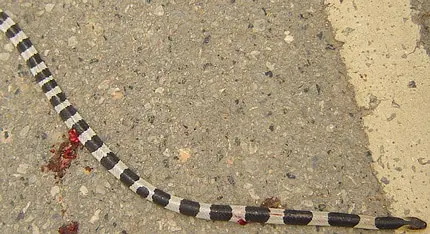When I click the link this lot comes up
I've been looking through these and lots of snake pictures come up !
What snake is the one ????
Change that crappy iPhone!!
Malayan Krait – Blue Krait – Highly Toxic Venom
Posted on 08 February 2010. Tags:
Bungarus candidus,
dangerous snakes,
malayan blue krait,
malayan krait,
thailand snake,
venomous snakes

Bungarus candidus. Malayan Blue Krait, Malayan Krait. Highly toxic venom. White/black or Yellow/black. Scroll down for 1 more photo.
Note: About 50% of all bites from this krait results in human death – even with the administration of anti-venin. Death is the usual result if no treatment is given. The closely related Bungarus multicinctus is ranked 3rd in the world for toxicity of venom (terrestrial snakes). Do be careful.
Bungarus candidus (Malayan Krait or Blue Krait)
Thais say: Ngoo tap saming kla, or ngoo kan plong
Length: Max length about 1.6 meters in Thailand.
Range: All over Thailand and much of southeast Asia.
Notes: I’ve seen these dead on the side of the road near rubber plantations. Their head is not nearly as large as the yellow/black banded krait. Be careful!
Habitat: Like flat country. Not found higher than 1200 m vertically often. Like to be close to water. Likes rice fields and rice dams. Likes to invade rat holes and use as a nest.
Active Time? The snake is mainly active at night and are not fond of the sunshine. They are shy and attempt to cover their head with their tales.
Food: Other snakes – primarily, but also lizards, mice, frogs and other small animals.
Defensive Behavior: Not usually very aggressive. Shy. They don’t bite unless provoked. Stepping too close to one might get you bit.
Venom Toxicity: Very toxic – even many times more so than the Naja kaouthia (cobras). Bungarus krait venom is neuro-toxic and attacks the human nervous system, shutting it down. Coma, brain death, and suffocation due to paralysis of the muscles necessary to breathe (diaphragm) are frequent causes of death. Death results usually 12-24 hours after a bite that is not treated. Little or no pain is usually felt at the bite location. The black/white kraits in Thailand are more toxic to humans than are the yellow/black kraits. The yellow-black kraits (
Bungarus fasciatus) can still kill you easily.
Here’s a short overview of what happened to one victim of a bite by Bungarus candidus (black-white striped krait):
A patient bitten by Bungarus candidus (Malayan krait) developed nausea, vomiting, weakness, and myalgia 30 minutes after being bitten. One hour later, ptosis and occulomotor palsies as well as tightness of his chest were noted. Respiratory failure requiring mechanical respiration appeared 8 hours after the bite and lasted for nearly 96 hours. The two bite sites were virtually painless and resulted in slight transient erythema and edema. No specific antivenin was available, and treatment consisted of respiratory support and management of aspiration pneumonitis. Recovery was complete. (Department of Medicine, Chulalongkorn University Hospital and the Queen Saovabha Memorial Institute of the Thai Red Cross Society, Bangkok, Thailand)
Handling: The banded and Malayan blue kraits are not known to bite during the daytime. However, at night time they bite rather easily, as evidenced by the numerous krait bites that occur at night to people usually laying down to sleep on the floor. Handholding the kraits for any reason seems rather absurd to me, yet snake-handlers across the globe do it regularly. The krait venom is so toxic, it’s just not worth the risk – however small.
Anti-venin: There is a specific krait antivenin that is given for krait bites. If you don’t have access to that antivenin you can ask the hospital if they have Tiger Snake antivenin – which can be used as a substitute for krait antivenin and works quite well.
Offspring: Lays 4-10 eggs. Juveniles are 30 cm long at birth. Hatch in June-July.
Classification:
Kingdom: Animalia
Phylum: Chordata
Subphylum: Vertebrata
Class: Reptilia
Order: Squamata
Suborder: Serpentes
Family: Elapidae
Genus: Bungarus
Species:
candidus
(Classified as Bungaris candidus)

Notice the thickness of the bands on this deadly Krait... Wolf snakes have similar coloring (stripes) but thinner bands. Wolf Snakes are harmless.

 Bungarus candidus. Malayan Blue Krait, Malayan Krait. Highly toxic venom. White/black or Yellow/black. Scroll down for 1 more photo.
Bungarus candidus. Malayan Blue Krait, Malayan Krait. Highly toxic venom. White/black or Yellow/black. Scroll down for 1 more photo. Notice the thickness of the bands on this deadly Krait... Wolf snakes have similar coloring (stripes) but thinner bands. Wolf Snakes are harmless.
Notice the thickness of the bands on this deadly Krait... Wolf snakes have similar coloring (stripes) but thinner bands. Wolf Snakes are harmless.